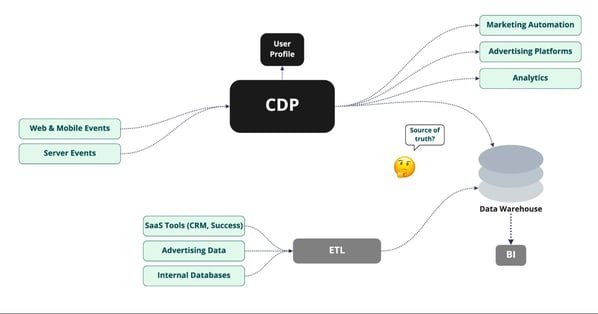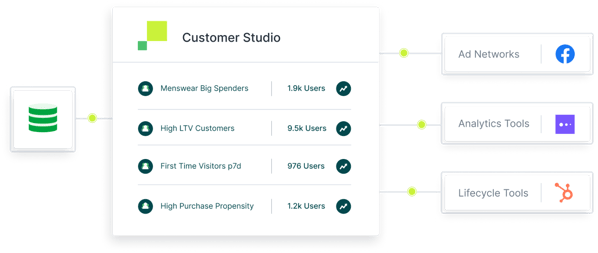As companies strive to maximize the value of their customer data and enhance their personalization strategies, the need for business and marketing teams to have direct access to comprehensive customer data within their has become more prevalent.
While all-in-one Customer Data Platforms initially seemed like the answer, these legacy solutions have proven to fall short on their lofty promises, leaving data and marketing teams to pick up the pieces.
Fortunately, a new era of Composable CDPs has emerged, empowering organizations to leverage a best-in-class solution that meets the unique needs of both data and marketing teams. This enables them to move faster than ever before.
The following article will explore how you can leverage a Composable CDP to enrich your customer data.
Table of Contents
How Legacy CDPs Work
have been around for a long time, and companies have relied on these platforms for years to power their customer-facing use cases.
Every legacy CDP vendor offers a number of bundled features, including:
- Data Collection: CDPs provide proprietary code that you can run on your website/app to capture behavioral data or user events like page views, purchases, or signups.
- Storage and Modeling: CDPs offer standard identity resolution modeling features to help you tie data from various sources to a single customer profile.
- : CDPs enable you to define and build custom audiences using your behavioral data for your downstream use cases
Because CDPs integrate with a wide variety of SaaS applications and databases, you are able to sync your customer data and audience to these downstream systems.
The fundamental problem that CDPs solve, helping you manage and activate your data at scale from a single source of truth, is not going away anytime soon. In fact, CDP demand has done nothing but continue to increase.
That said, with the rapid adoption of modern cloud data warehouses like Snowflake, , , and , many organizations are now realizing it no longer makes sense to maintain an architecture that creates two conflicting sources of truth — one in the CDP and one in the data warehouse.

With data and marketing teams working off of two independent sources of truth for customer data, several problems are introduced.
Inconsistent data between your BI and operational tools, inflated storage costs, security concerns, and an inability to activate all available customer data are all drawbacks to this now legacy CDP architecture.
Instead, organizations like and , are choosing to implement an architecture that enables them to activate data directly from a single source of truth: the cloud data warehouse.
Doing so unlocks what is now known as the Composable CDP.
With a legacy CDP, you have to implement an entirely new technology outside of your existing data infrastructure.
With a , you simply activate the data you already have in your data warehouse without adding any additional steps or data stores.
Previously, moving data out of the warehouse was extremely challenging. Data teams were forced to either build and maintain custom integrations or download ad-hoc manual CSV files.
However, with the introduction of tools like and , this is no longer the case. Anyone can now seamlessly move data out of the warehouse in minutes.

Compared to a legacy CDP, there are many benefits to this approach.
- Flexibility: Legacy CDPs have very rigid modeling capabilities, locking you into a strict user and account-based model. Composable CDPs are unencumbered by these structural limitations because they support multiple entity types and related models (ex. relating users to accounts or other objects).
- Data Availability: Legacy CDPs only focus on event-level clickstream data, creating a fragmented view of your customer. Composable CDPs have access to any and all of the data living in your data warehouse–not just clickstream events (ex. data science models).
- Cost: With a legacy CDP, you pay twice to store and process the data that you already have within your own warehouse. With a Composable CDP, you can take advantage of your existing data investments rather than purchasing yet another off-the-shelf tool.
- Time-to-Value: Legacy CDPs can take over a year to implement, and that’s not even accounting for the onboarding time it takes for your teams to learn how to use the tool. The modularity of a Composable CDP allows you to start activating your data immediately with the tools your teams are already familiar with.
- Security: Legacy CDPs force you to store data outside of your own cloud infrastructure, giving you little control over what happens to it. With a Composable CDP, your data is never stored outside of your existing data infrastructure, giving you full governance and control over how it’s managed.
Example Use Case: HubSpot + Hightouch
HubSpot’s CRM platform allows you to manage customer interactions, automate marketing workflows, and optimize sales funnels.
is one way to turn your existing data warehouse into a Composable CDP. This tool allows data and marketing teams to sync the valuable insights from their data warehouse to a CRM.

Here are a few other ways Composable CDPs help businesses create hyper personalized omni-channel campaigns and workflows that drive better results.
Profile Enrichment
Using a Composable CDP, you can access any and all of the custom data models living in your warehouse — such as lifetime value, last login date, active users, active tickets, features enabled, , likelihood to purchase, etc.
You can then sync that data directly to objects and fields that you can leverage in your CRM for personalization and segmentation.
Audiences
Let’s say your marketing team wants to target a list of shopping cart abandoners with a special coupon to encourage them to check out. Or maybe your product team wants to send an email to inform inactive users of a new feature.
In either case, a Composable CDP can easily deliver the data from your data warehouse to your CRM.
Workflows and Sequences
It’s easier for your teams to build more comprehensive workflows and sequences using the audiences that your data team defined in your warehouse.
For example, you can automatically enroll users into marketing campaigns based on their audience type or the attributes that you’ve outlined in your CRM.
You can also use these attributes to create different branches of the workflows based on user activity, engagement, or attributes.
This has huge implications from a sales standpoint because you can use workflows to route new leads to individual sales reps so they can take action faster.
The Bottom Line
Composable CDPs are the new era of data management. They enable marketing, sales, and operations teams to improve operational performance and streamline their workflows.
![]()